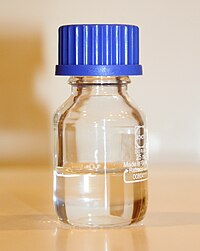
Photo from wikipedia
Abstract Recent experiments have shown that photoexcited pyridine can abstract a hydrogen atom from a water molecule in pyridine-water clusters containing at least four water molecules. To explain these findings,… Click to show full abstract
Abstract Recent experiments have shown that photoexcited pyridine can abstract a hydrogen atom from a water molecule in pyridine-water clusters containing at least four water molecules. To explain these findings, we explored the electron-driven proton-transfer reaction from water to pyridine in pyridine-(H2O)n, n = 1–4, complexes with ab initio methods. It is shown that the photoinduced electron/proton transfer reaction is energetically possible for all clusters. The calculations reveal that the hydrogen bond between pyridine and the adjacent water molecule is weakened (strengthened) in the 1nπ∗ (1ππ∗) excited state, which is unfavorable (favorable) for the H-atom transfer reaction. For pyridine-(H2O)n clusters with n = 1–3, the steepest descent path leads to a local minimum of 1nπ∗ character, while for the pyridine-(H2O)4 cluster, this path leads to a local minimum of 1ππ∗ character. The transition state calculations show the presence of this 1ππ∗ minimum substantially reduces the barrier height for the H-atom transfer reaction. These results provide a tentative explanation of the experimental observations.
Journal Title: Chemical Physics
Year Published: 2018
Link to full text (if available)
Share on Social Media: Sign Up to like & get
recommendations!